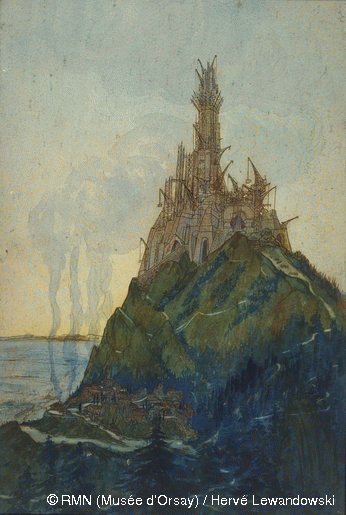Architectures de l’étrange
by Gina Balibrera
Fifteen minutes before the Musée D’Orsay in Paris closed its doors, I entered the final room of my visit to the museum and encountered two “architectes de l’étrange”: François Garas and Henry Provensal. What struck me most about the work of both artists is the technical precision with which they approached their dreamlike subjects. Of course. The young men were gifted architects who, later in their careers, would go on to receive national awards and high-ranking commissions, and both trained at the prestigious École des Beaux-Arts in Paris. That these pieces exist at the top of wooded mountains, reach in skyward vertical lines, and reveal interior rooms that seem to open infinitely into each other, is especially strange in contrast with images of realized architectures of turn of the century Paris. That these pieces highlight the technical skills of these architects, the mastery of line, fealty to each structure’s projected physical integrity (and if you find yourself curious, take a look, especially at the earnest series of plans, each successive drawing more convincingly applied: this building might actually work) reminds me of Gabriel García Márquez’s famous anecdote about his grandmother telling “fantastic stories with a brick face.”
Architectures de l’étrange Read More »
by Gina Balibrera
Fifteen minutes before the Musée D’Orsay in Paris closed its doors, I entered the final room of my visit to the museum and encountered two “architectes de l’étrange”: François Garas and Henry Provensal. What struck me most about the work of both artists is the technical precision with which they approached their dreamlike subjects. Of course. The young men were gifted architects who, later in their careers, would go on to receive national awards and high-ranking commissions, and both trained at the prestigious École des Beaux-Arts in Paris. That these pieces exist at the top of wooded mountains, reach in skyward vertical lines, and reveal interior rooms that seem to open infinitely into each other, is especially strange in contrast with images of realized architectures of turn of the century Paris. That these pieces highlight the technical skills of these architects, the mastery of line, fealty to each structure’s projected physical integrity (and if you find yourself curious, take a look, especially at the earnest series of plans, each successive drawing more convincingly applied: this building might actually work) reminds me of Gabriel García Márquez’s famous anecdote about his grandmother telling “fantastic stories with a brick face.”




